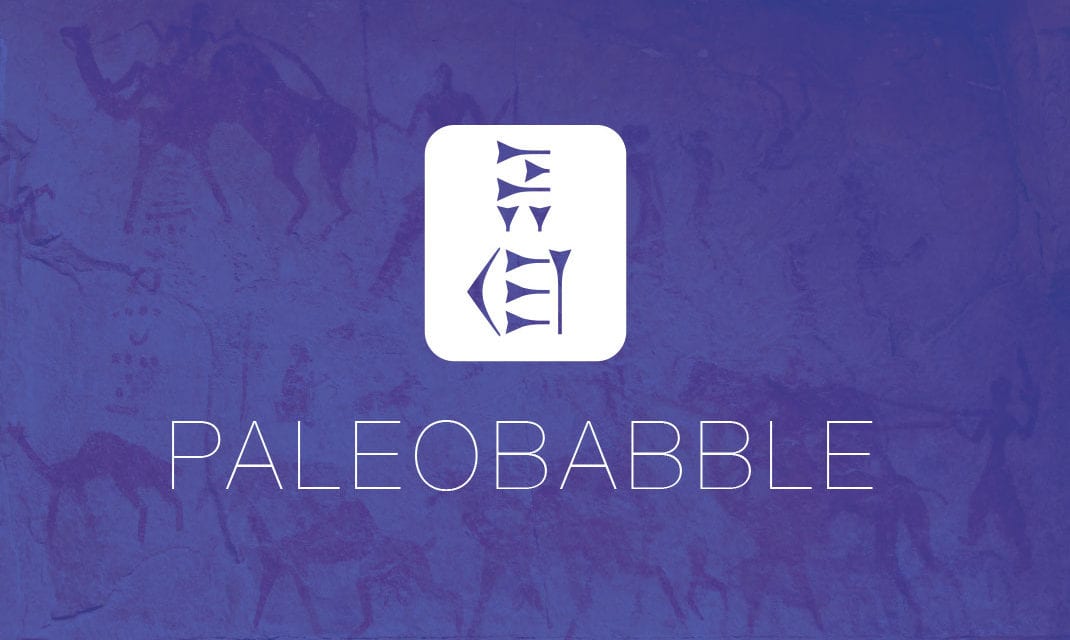I just wanted to post an update on what has emerged as a controversy regarding the identification of Akhenaten’s mummy (or not). The Egyptology News blog has been keeping up with the discussion pretty closely. Yesterday a post appeared in favor of confirmation that the mummy of KV55 is indeed Akhenaten. It’s cranial features certainly would be in concert with that (below).
 The identification was put forth as a result of new DNA testing on several mummies published a month ago in the Journal of the American Medical Society (JAMA).
The identification was put forth as a result of new DNA testing on several mummies published a month ago in the Journal of the American Medical Society (JAMA).
However, the KV64 blog has a pretty technical summary on why the KV55 mummy is “probably not” Akhenaten, and argues that the DNA evidence is on *that* side of the debate. Here are the summary’s conclusions:
Combining the DNA data with known historical facts shows that Akhenaten is probably not the KV55 mummy.
It is tempting to consider the KV55 mummy (Tutankhamun’s father) alternatively as Smenkhare although this can be no more than conjecture on the basis of the available data.
There is a very strong probability of a second line of descent from Yuya and Thuya to the KV62 foetuses.
This secondary line of descent is consistent with the historical Nefertiti.
There is a strong probability of second line of descent from Amenhotep III to the foetuses not via the KV55 mummy.
This second line of descent is consistent with the historical Akhenaten.
It is possible to construct a family tree along these lines which fully fits the STR analysis published in the JAMA paper and which assumes Nefertiti is a granddaughter of Yuya and Thuya.
It is possible, but not essential, to accommodate the Younger Lady and KV21B mummies in this revised family tree as further daughters of Akhenaten and Nefertiti.
Notice that the DNA evidence has received a thorough going-over by qualified interested parties of differing opinions. That’s called peer review. No one is “noticing” any alien DNA. That’s too bad for all those who wanted Akhenaten as an extraterrestrial.






I still don’t believe that KV 55 is Ahkenaten’s mummy. Mu belief is that Ahkenaten was never buried in the Valley of the Kings precisely because he did not believe in the Egyptian funerary rituals for the dead. He worshupped only one god, the sun disk, Aten. He had specific instructions that should he die outside of Egypt, he should be returned and be buried in the rock-cut tomb on the cliff in Amarna ( or Ahket-Aten) which he prepared for his own burial chamber.
Ahkenaten had unimaginable wealth compared to his son, Tut. All his wealth are in that lost tomb, if it could be found today.
I hope the searchfor his lost tomb would still continue. . ..
yes you are right, i believe too that ahknaten final resting place was never meant to be in the valley,but what if king tut moved the body of his father in kv 55 in order to protect him?
Basically the facts are this: We have a male who is the father of Tutankhamun and who shares, I believe it was, grandparents with Ankhenaten and that is it. Therefore, to claim that it is absolutely Ankhenaten is pure fallacy. There are too many candidates in an unmarked tomb with too many missing key players.
Tutankhamun changed his name, reverted back to the classical religion, and moved the capitol back to thebes and out of amarna- that’s disconnection and disassociation if I ever saw it. Therefore, I think he would be unconcerned with the body of a man he rarely saw in such an intricate palace court that the court hated with a passion as it was.
Also, Mr. Khanser, that’s a fairy tale if I ever heard one. Unless you can back up such a claim that Ankehnaten actually had some sort of will, I’d chalk it up to someone’s over-romanticised imagination. The fact of the matter is that Ankhenaten’s mummy has most likely been completely destroyed. The egyptians really, and I mean really, hated this guy, and the best way to wreak revenge on those you seriously detest is to completely eradicate their mummy, as the Ka needs, in egyptian tradition, the body to return to periodically, and without a body, they cannot survive in the afterlife and perpetuate immortality. So, if you really wanted to send someone to literal oblivion, you destroyed their remains, and that is most likely what happened to the Heretic King, Ankhenaten.
It’s “Akh”enaten, not “Ankh”enaten (two different signs with very different meanings).
And I tend to agree about the obliteration of the body logic and its basis. That said, we don’t actually know. But it would certainly be no surprise.
ewwwwwy
I recently heard of this discovery of Akhenaten’s mummy and I personally do not believe it.
Suggestion:
He certainly would have known of the hatred of him and his alternate beliefs and would have been warned about his final assasination. I suggest he secretly left Egypt leaving family behind
with a few artisons and traveled to South America where he had been trading for gold for years and with assasins on his trail to complete his death, he was assisted by Peruvian locals out into the Pacific Ocean-Easter Island where he influenced the tribes of the “long ears” to cut the vulcanic stone bodies of their new ruler so the “Moai” stones were moved out to watch the sun
along the shoreline in honor of their new ruler who they watched many times looking out to sea with a false hope that he might one day be rescued and returned to his beloved family and Egypt. Note these sculptures closely and especially that they are of the same face and body with morphanic alterations the long heads(non polynesian profile)and the extra long digits of the hands wrapping around a protubering belly.
The most important of all is the conicle shaped head piece which all had and curiously was made of red vulcanic stone not to mention the elongated Egyptian eyes painted in. Do your own comparisons between this statue and those from the new unique stylized artwork of Akhenaten’s own artisens who often illustrate him wearing that unique red headpiece. I do realize that there is a big rift in time frame for my suggestions according to Archeologists however previous history is always being rewritten. Is it possible that his remains might one day be found on Easter Island?
Are you mad?
nope; I just don’t like to see people deceived. Pretty simple. Are you?
Over 10 years ago I worked with a black woman at a Defense University who had the same cranial shape, elongated narrow face, and almond shaped eyes as Akhenaten. She was very attractive in her own odd way. Since I worked in the DC area, I have had contact with a large population of blacks and I can confidently say she was unique in appearance. I have been retired for a number of years but could track this lady down if anyone wants to compare DNA to the Pharaoh. I believe he was simply an odd looking man from a rare tribe of blacks, possibly Nubians, that was part of the diverse ethnic population of that time. My friend also had the skinny, boney, body shape that he had. Since she usually wore her hair in a weave the shape of her skull was pretty obvious.
there may be genetic reasons for Akhenaten’s appearance (though the latest research casts doubt on it, depending on its interpretation) and so this woman may have (potentially) the same genetic issues. Akhenaten was not black, however. The Egyptians very clearly distinguished themselves artistically from negros.
Based on KV 55 not being 100% Akhenaten through DNA, it is becoming more plausible that Akhenaten and Moses are the same person. : )
uh, no, it isn’t. Do you realize what you just argued? “The mummy in KV 55 isn’t Akhenaten, so the person it isn’t must be the same as another person it isn’t.” I’ve seen illogical statements before, but that’s a hall-of-famer. But no doubt you have some other reasons (I hope) — none of which I expect to be coherent, though, since I’m familiar with this topic. But I’ll ask: on what basis do you say this?
MSH wrote: “The Egyptians very clearly distinguished themselves artistically from negros.”
First of all, that statement is both false in context and in definition. During the time of Akhenaten, there was no “Negroes” or black. There was no Egypt – an foreign term. And “Egyptians” would not have classified themselves differently “artistically” – we’re not talking art here.
Kemetic civilization, given its location, was very diverse – having Greek and Roman Kings as well as African kings. One only need look at America, Israel, or modern day Egypt to see the mixture of people. Over time, the representation and demographics has involved as well as social pressures e.g. Rawanda genocide.
But make no mistake in science. If we came out of Africa, the “Egyptians” were black Africans by dress, religion, and practice. Maybe not a particular tribe. Maybe of aggregation of tribes and ethnic groups. They were not unique on the African continent.
To say otherwise is to have your cake and eat it too i.e. you cannot push evolution and “out of Africa” theory and try to have one of the oldest documented civilizations in Africa be anything but black.
This is nonsense. Libyans and Nubians were black. That is the way they appear in the iconography, in distinction from Egyptians, which are ubiquitously depicted as reddish (or dark brownish – very tanned) in skin.
I agree for the most part. But Libyans were not depicted with “black” skin. More than skin color, the Egyptians should ethnicity based on costume and accouterments.
Libyans were depicted with dark skin, though not only dark skin, or always with dark skin.
Look, if you want to ask whether Egyptians were black or white, the answer is both. Ethnicity was defined culturally, and not by the standards used more recently. Yes, the Egyptians were located in Africa, but that doesn’t mean that they were black. If you really want to feel pride in “Black Egypt” I suggest you look up the Nubian dynasty with kings like Piye (Piankhy), who were pretty effective. If you want to be taken seriously, please abandon Afrocentrism and come to the table with concrete evidence and without a chip on your shoulder. What has happened to people of color in the last 500 years cannot affect how we, as scholars, study the past scientifically.
Egyptians were not ethnically Negroid. Their material culture (art, mostly) tells us that loud and clear. But who cares? There was Negroid high culture elsewhere.
The simplest answer is usually the correct one. Not sure why there is so much arguement still over the ethnicity of ancient egyptians. Is it really that hard for people to accept that the people who populated the region of north africa for over three thousand years might not be that ethnically different than their ancestors that populate that region today, only two thousand years later?
Queen Tiye is the mother of Akhenaten and the grandmother of Tutankhamun. Her remains have been identified as the “elder lady” of KV 35. Google it. Her hair wasn’t kinky, infact none of the ancient egyptian mummies that have been found with hair intact have posessed what would be scientifically classified as “negroid” hair.
They weren’t black and they weren’t white. For those looking to hang their hat on great acheivements of black cultures the Nubians did amazing things. They had kings and queens, pyramids and mummies too. The only people that can really claim a kinship and shared ancestry with ancient egyptians are…. Egyptians.
thanks
Well said.
!LOL!